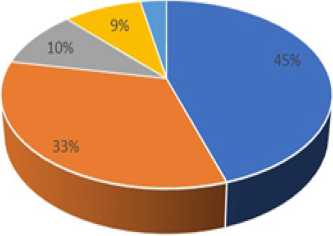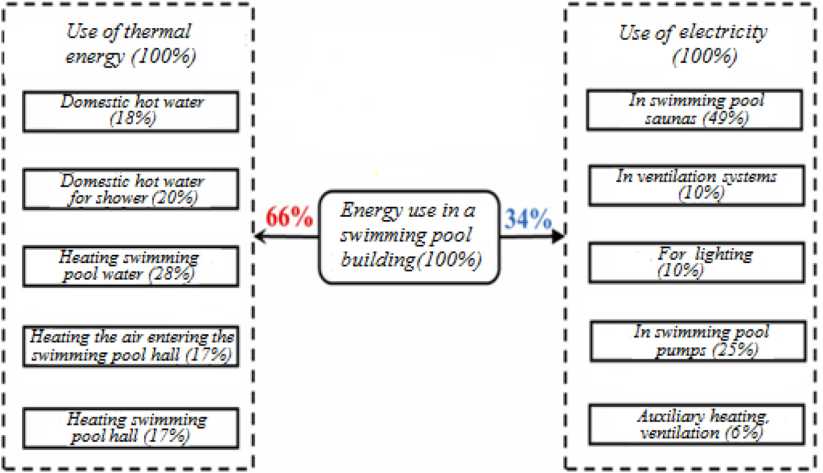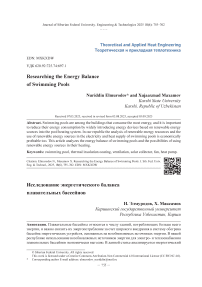Researching the Energy Balance of Swimming Pools
Автор: Elmurodov N., Maxamov X.
Журнал: Журнал Сибирского федерального университета. Серия: Техника и технологии @technologies-sfu
Рубрика: Исследования. Проектирование. Опыт эксплуатации
Статья в выпуске: 6 т.18, 2025 года.
Бесплатный доступ
Swimming pools are among the buildings that consume the most energy, and it is important to reduce their energy consumption by widely introducing energy devices based on renewable energy sources into the pool heating system. In our republic the analysis of renewable energy resources and the use of renewable energy sources in the electricity and heat supply of swimming pools is economically profitable too. This article analyzes the energy balance of swimming pools and the possibilities of using renewable energy sources in their heating.
Swimming pool, thermal insulation coating, ventilation, solar collector, fan, heat pump
Короткий адрес: https://sciup.org/146283183
IDR: 146283183 | УДК: 620.92:725.74:697.1
Текст научной статьи Researching the Energy Balance of Swimming Pools
With the rapid growth of the world's population, the need for energy to meet their various needs (for example, household appliances, transportation, and production) is constantly growing. This leads to an increase in the use of traditional fossil fuel sources and environmental problems. Therefore, it is important to widely introduce renewable energy devices in the domestic sector and production, increase energy efficiency, and reduce exhaust gases emitted into the air from traditional energy devices.
In this regard, the European Union aims to increase its energy efficiency by at least 32.5 % from 2021 to 2030 and to increase the share of renewable energy to 32 % [1]. In the «Renewable Energy Law» adopted by the Chinese government, it was determined to increase the share of renewable energy in the production of electricity by 22.16 % [2].
In our country, in the field of renewable energy development, the Resolution of the President of the Republic of Uzbekistan No. PP-3012 dated May 26, 2017, provides for increasing the share of renewable energy sources in the structure of electricity generation capacities from 12.7 % to 19.7 % by 2025 [3].
In developed countries, the energy consumption of buildings has increased from 20 % to 40 % [4]. Sports facilities, including swimming pools, are large consumers of heat and electricity. Therefore, scientific research by scientists and researchers around the world to reduce the energy consumption and energy losses of swimming pools is of great importance in the construction of swimming pools and the introduction of innovative energy-saving technologies in them.
Swimming pools are considered as buildings with high energy consumption, with a variety of uses, including heating the water, heating the pool hall, ventilation systems, lighting the building, and operating filtration pumps.
Research method
According to the European standard prEN12831–2002 EN, the heat load in the hall of an indoor swimming pool building is calculated as follows [5]:
-
1. To obtain the total calculated heat loss of a building, the heat losses of all heated rooms are calculated.
-
2. The total heat loss for ventilation of the building object is determined by summing the calculated heat losses for ventilation of all heated rooms.
-
3. The total heat loss of the building is determined by adding the heat losses in the building's heat conduction and ventilation system.
-
4. To determine the heat capacity of the building, the heat capacity of all heating rooms is calculated.
-
5. The total heat load of the object is calculated by adding the total heat loss of the building and the heating capacity.
Heat is lost in swimming pool buildings mainly in two ways. The first is directly in the swimming pool itself through convective, evaporative, radiation, and heat conduction losses. The second is through convective heat losses through the ceilings, walls, and windows of the pool building, the ventilation system, and other technological equipment of the building.
A large portion of the heat loss directly from a swimming pool is due to evaporation of the pool water. Researchers Zuccari et al., in a study of swimming pools in Italy, found that the use of thermal insulation coatings reduced evaporative heat loss by 50 %, which is approximately 31 % of the total heat requirement [6].
Humidity is a very important parameter in swimming pools, and the ventilation system controls the humidity of the swimming pool air and the humidity of the outside air entering the pool, ensuring indoor air quality and a comfortable microclimate. This is a process that requires a large amount of energy consumption. One of the solutions to reduce energy costs for heating the air in the ventilation system in swimming pools is to control the air parameters depending on the heat load of the pool and the time of day, and to select an energy-efficient air heating system. Researchers Ratajczak and Szczechowiak, when studying the ventilation systems of swimming pools in Poland, found that a heat pump is the best heat source for the ventilation system, and that heat pump ventilation systems are 20 % more expensive than other systems, but are 18–20 % more energy efficient in terms of energy consumption [7].
The evaporation process of the pool water absorbs heat from the air and lowers the air temperature. Therefore, energy demand can be reduced by keeping the relative humidity at an optimal level. According to the norm of Sanpin 2.1.2.1188–03, the permissible level of relative humidity in swimming pools is set at 60–65 % [8].
In indoor swimming pool buildings, 45 % of energy consumption is for pool hall ventilation, 33 % for pool water heating, 10 % for heating and ventilation of the rest of the building, 9 % for heating and equipment, and 3 % for hot water supply (Fig. 1) [9].
A study by researchers of an indoor swimming pool located in a recreation center in Poland found that the use of high-quality thermal insulation materials in the walls of indoor swimming pools can significantly reduce the building's energy costs. Approximately 50 % of the heat supply is spent on heating the pool water, domestic hot water, and showers [10].
-
■ swimming pool hall ventilation

-
■ swimming pool water heating
heating the swimming pool building swimming pool building lighting
-
■ hot water supply
Fig. 1. Diagram of total energy consumption of indoor swimming pool buildings
In a swimming pool building, the presence of various rooms besides the pool, such as washrooms, dressing rooms, offices and storage rooms, plays an important role in the energy consumption of the building. A pool building requires electricity for lighting the room, pool hall lights, water pumps, building automation system, as well as office and administrative needs [10].
Swimming pools use energy in two ways. One is observed through the heating system and the other through the use of electricity. Of the total energy consumption of swimming pools in Finland, 66 % is heat energy and 34 % is electricity consumption (Fig. 2) [11].
Australia's water centers use electricity and natural gas as energy sources. Electricity was mainly used for melting, motors, pumps and fans, and gas was used for water and space heating. Data collected for aquatic centers in the Australian state of Victoria indicate that the average ratio of gas and electricity usage is approximately 77 % and 23 %, respectively[12].
There are many water heating technologies for heating swimming pool water and domestic hot water supply. They can be classified as follows. (Table 1)

Fig. 2. Total energy consumption of swimming pools in Finland
Table 1
|
Energy sources |
||
|
Traditional |
Regenerable |
Hybrid |
|
Gas boiler |
Solar powered system |
Conventional + renewable energy sources |
|
Oil fuel boiler |
Heat pump |
|
|
Coal boiler |
Accumulation of heat |
|
|
Electric heater |
Geothermal |
|
|
Biogas |
||
|
Waste energy |
||
There are many ways to heat swimming pools, but the wrong heating method can be costly in terms of both economic and energy efficiency, so it is important to thoroughly study the different heating methods to choose the right option.
In the world, the following energy sources are widely used for heating swimming pool water: natural gas, liquid fuels, coal, household waste, biomass, solar energy and other renewable energy sources.
Heating systems in the building of swimming pools are used for heating the pool complex and hot water supply. Hot water is used for the following purposes:
-
1. Heating the swimming pool water;
-
2. Heating system — convection or underfloor heating system;
-
3. Heating the ventilation air;
-
4. Preparation of domestic hot water, including hot water for showers.
The selection of the necessary heating systems for heating water in a swimming pool is determined by the location of the pool and the technological capabilities of the facility. The most common heating systems for swimming pools include:
-
• District heating system (heating substation);
-
• Gas boiler;
-
• Biomass boiler;
-
• Electricity (electric heaters or heat pumps);
-
• Solar energy.
Literature Review
The district heating network was usually used as the heat source for heating the water of swimming pools in Poland [13]. It is effective to use this heating system in cities with high efficiency of the central heating network.
Natural gas heating of swimming pools is one of the most widely used heating systems in the world. In this regard, a study was conducted at the Central Queensland University (CQU) Community Sports Centre in Rockhampton, Australia, which measured 25 m by 18 m, had an average depth of 1.8 m, and held 810,000 liters of water. The swimming pool was programmed to use natural gas to maintain a constant temperature of 28 °C in cold climates. The university spent approximately $34,000 per year on energy costs to heat the pool, with an average daily cost of $380 [14].
In addition, scientists in the field I. S. Marinopoulos, K. L. Katsifarakis studied an outdoor swimming pool heated with natural gas in Thessaloniki, Greece. Two gas boilers with a capacity of 1100 kW were used to heat the pool. They found that the annual cost of natural gas was reduced from 171,974 euros to 84,441 euros by using a thermal insulation coating to reduce the energy consumption of the pool [15].
Traditional heat sources can be used to heat water in swimming pools. However, this heating process is mainly associated with increased costs and large energy consumption. Therefore, the use of renewable energy sources or hybrid energy systems is an effective solution to reduce energy consumption.
Katsaprakakis' research compared passive and active renewable energy-based swimming pool heating systems in Southern Europe from both a technical and economic perspective. His results show that an active renewable energy-based system can significantly reduce pool heating costs [16].
Lam and Chan analyzed hotel swimming pools in Hong Kong, taking into account the main energy losses in evaporation, radiation, convection, and fresh water supply. Based on the results of the study, they found that using a heat pump instead of traditional electric heating and gas boilers for pool heating would save energy costs of HK$275,700 over a 10-year period [17].
In this regard, researchers from the Department of Civil Engineering at the Technical University of Denmark, Mark Dannemand, Simon Furbo, and Alfred Heller, conducted scientific research on heating indoor swimming pools in Danish summer houses. They created a pool model measuring 4.8 m x 3.5 m and 1.3 m deep to heat the pool and pool air, and studied individual electric heating systems and solar heating systems combined with them to heat the pool and pool room. In the proposed system, the pool room is heated by a 3.5 kW electric heating system from the floor, and the pool is heated by 1 kW electric heating. In this model, the electric heating device is used to heat the pool and its air, and as a backup if the solar collectors cannot meet the heat demand [18].
Jordanian researchers Ahmad Aboushi and Abeer Abu Raed have demonstrated and analyzed the feasibility of replacing a diesel-fired heating system with a solar vacuum collector for a 45m3 swimming pool with a surface area of 30m2, a depth of 1.5m, and a heating system based on solar energy. The results of the study showed that the fuel savings when using a vacuum solar collector for heating the pool are 100 % in summer and 50 % in winter [19]. It was found that this system can save 9166 kg of fuel per year. The payback period for the system is estimated at 1.5 years [19].
In order to reduce the traditional fuel consumption for heating swimming pools, geothermal heat pumps and vertical geothermal heat exchangers were additionally used by the Greek researcher Katsaprakakis. In this case, the annual electricity consumption of the geothermal heat pump for heating the swimming pool was 35223 kWh. This reduced the annual heating load by 90 %, and the remaining 10 % of the energy was covered by the proposed active heating system [16].
Iranian researchers Rahim Mahmoudi et al. designed a new intelligent management and control system to optimize the energy consumption of a 16 x 33 m swimming pool at the Hafte-Tir Swimming Center in Urmia city. [20] Experimental results of the proposed project show that the proposed system allows a significant 15.1 % reduction in natural gas consumption for heating the pool.
A system for heating indoor swimming pools using a biomass boiler and additional solar collectors was proposed by J. P. Delgado et al. [21]. Studies conducted within the framework of this system showed that the annual heating demand of a swimming pool is 162 kWh from biomass energy and 207 kWh from solar energy.
In [22], Hahne and Kubler modeled an outdoor swimming pool using the TRNSYS program and found that the use of outdoor solar collectors can reduce the natural gas consumption for swimming pool heating by 40 %.
Conclusions
The following conclusions were drawn from the analysis of the results of the theoretical and practical research:
60–65 % of the total energy consumption of swimming pools is heat energy and 35–40 % is electricity energy.
-
50 % of the heat in swimming pools is spent on heating the pool water, domestic hot water and showers.
A large part of the heat loss in swimming pools occurs through the evaporation of pool water. The use of thermal insulation coating reduces heat loss through evaporation by 50 % and the total pool heat demand by 31 %.


